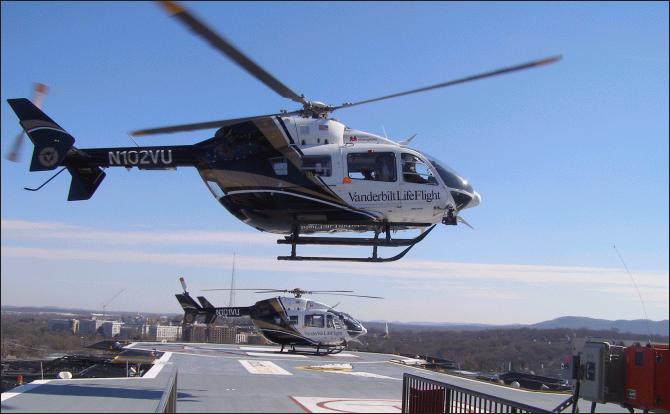<Straight Up>
EMS
Helicopter Bases in Major Countries
How many emergency medical service (EMS) helicopters are in service throughout the world? The total number of bases in the countries below is more than 900, with roughly another 100 in other various countries. The chart below shows EMS data gathered from these major countries. The total number of EMS-helicopters will be more than 1,000 in the world.
|
|
|
|
|
|
|
U.S.A. |
|
|
|
|
|
Germany |
|
|
|
|
|
Switzerland |
|
|
|
|
|
Austria |
|
|
|
|
|
France |
|
|
|
|
|
U.K. |
|
|
|
|
|
Italy |
|
|
|
|
|
Spain |
|
|
|
|
|
Netherlands |
|
|
|
|
|
Japan (Doctor-Heli) |
|
|
|
|
|
Total |
|
|
|
|
The right-most column in the above chart represents the density ratio of EMS-helicopter service to land area. Each EMS service covers 7,850 square kilometers, based on the assumption that coverage extends from the base in a 50-km radius. For instance, Germany's density ratio is 1.7, if one multiplies the number of EMS-helicopter bases in Germany by 7,850 square kilometers, and this value is then divided by the national territory area figure (7,850 x 80/357 = 1.759). That is, the 80 EMS-helicopter bases in Germany cover an area equivalent to 1.7 times that of the country's land area. The U.S.'s density ratio is 0.5, which means the distribution of bases is capable of covering the half the country's territory. Network density of bases is thin in the U.S., but this is unavoidable, given the country's vast size. But if an EMS-helicopter base distribution chart of the U.S. were superimposed on a U.S. population distribution chart, one would find that 75 percent of U.S. citizens are covered by EMS-helicopters.
Two particularly high-density EMS-helicopter base distribution countries are Switzerland and Austria. Both have EMS-helicopter coverage equivalent to three times their land area. A large portion of each of these countries is covered by steep mountainous terrain, making rescue missions by ground ambulance in these areas practically impossible. EMS-helicopters are indispensable for providing rescue service in rough terrain, so naturally the distribution of EMS-helicopter bases is high in these countries.
Switzerland's helicopter medical emergency service system framework, in particular, can deliver a doctor within just 15 minutes to an accident scene at the base of the Alps, nights, included. Obviously, emergency medical service availability in Switzerland is scarcely a problem.
Japan's coverage density figure of 0.2 is really poor, compared with Switzerland and other advanced countries. The recently enacted "Doctor-Helicopter Special Law" must act as a backup to improve Japan's helicopter emergency medical service coverage. In this capacity, the new law will benefit the nation's welfare.
printed in Japan Aviation Weekly of August 27, 2007)
上の英文は、日本航空新聞社の週刊英字紙に掲載されたものである。山野豊氏に翻訳していただいた。もともと外国向けの記事なので、日本ではよく知られた内容かもしれぬが、念のために要旨は下の通りである。
主要国の救急拠点と配備密度
救急ヘリコプターは、いま世界中でどのくらい飛んでいるだろうか。下の表は、アメリカとヨーロッパの主要国についてまとめたものだが、これだけで拠点数900ヵ所を超える。他の国も合わせると、世界中では1,000機を超えるであろう。
|
|
|
|
|
|
|
アメリカ |
|
|
|
|
|
ドイツ |
|
|
|
|
|
スイス |
|
|
|
|
|
オーストリア |
|
|
|
|
|
フランス |
|
|
|
|
|
イギリス |
|
|
|
|
|
イタリア |
|
|
|
|
|
スペイン |
|
|
|
|
|
オランダ |
|
|
|
|
|
日本(ドクターヘリ) |
|
|
|
|
|
合 計 |
|
|
|
|
この表の右欄は、救急拠点または救急ヘリコプターによってカバーされる国土の割合を示す「配備密度」である。各拠点が半径50kmの地域を担当すると仮定すれば、それによって覆われる面積は7,850k㎡になる。これに各国の拠点数を掛けて国土面積で割ると、たとえばドイツは1.7になる。すなわち救急ヘリコプターのカバーする面積が国土の1.7倍に相当し、重なり合って救急システムが組まれていることになる。次のアメリカは0.5だから、ヘリコプターでカバーされる範囲は国土の半分程度である。広い国なのでやむを得ないかと思われるが、人口分布図に重ねて見ると、実は米国民の75%がヘリコプターの保護下にある。
配備密度の高い国はスイスとオーストリアである。いずれも国土の3倍前後の密度になる。これは両国ともにアルプス山岳地が多いためで、けわしい山の中は救急車では時間がかかり、実際に走れないところも多い。どうしてもヘリコプターが必要で、配備密度も高くなる。とりわけスイスの場合は、アルプスの谷間でも15分以内に医師が飛んでゆく態勢を取っており、夜間飛行もおこなうので救急医療に関する過疎問題はほぼ解消された状態にある。
こうした先進事例にくらべて、日本の0.2という数字はいかにも低い。この現状から脱却し、事態を改善するのが、このほど制定された新しい「ドクターヘリ特別法」の目的にほかならない。法律のもたらす効果に期待したい。

(西川 渉、2007.9.4)
